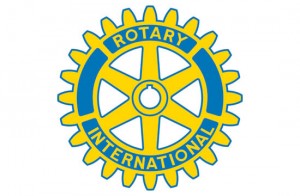By Susan Hanf and Joe Derr
Rotary International News — 17 August 2010
The current Rotary emblem, with keyway. 
The Rotary emblem, unchanged since 1924, was redesigned many times in the early years of the organization.
In 1905, Montague M. Bear, an engraver and member of the Rotary Club of Chicago, sketched a wagon wheel with 13 spokes. When fellow club members began to complain that the design was static and lifeless, Bear added flourishes that made the wheel appear to ride on a bed of clouds. Unfortunately, some members felt the clouds looked like dust, defying the laws of gravity by being kicked up on both sides of the wheel.
Bear responded by superimposing a banner with the words Rotary Club over the clouds.
In 1911, Secretary Chesley R. Perry recommended that “action be taken by the National Association to establish the wheel as the basic part of the emblem of every Rotary club.” Clubs were invited to submit designs to an emblem committee before the 1912 convention in Duluth, Minnesota.
The Duluth convention provided some definition. “The emblem consists of the basic principle of a wheel with gears cut on the outer edge. … The spokes are to be so designed as to indicate strength; the object of the gears … being twofold; to relieve the plainness of the design, and … symbolize power.”
The word Rotary appeared at the top and International Association at the bottom. Clubs were encouraged to use a similar design, placing the name of their city at the bottom in place of International Association. The number of spokes and cogs was unspecified.
As a result, numerous variations on the emblem were in use by 1918. The Board appointed Charles Mackintosh, of the Rotary Club of Chicago, and Oscar Bjorge, of the Rotary Club of Duluth, to the Special Committee to Standardize the Rotary Emblem.
Bjorge drafted an emblem with six spokes and 24 cogs, giving it a sturdy appearance. In this design, the number of teeth and spokes was intended to reflect a real, working gearwheel, and not any aspect of Rotary’s history.
In November 1919, the Board adopted Bjorge’s design and a detailed description, and the 1921 convention formally approved them. For many years, descriptions of the emblem simply referred to a 1920 article in The Rotarian, “Redesigning the Rotary Wheel,” which announced the Board’s decision.
By 1924, Bjorge’s design had been modified to include a keyway. This addition has been attributed to Will R. Forker, of the Rotary Club of Los Angeles. He was reported to have said Bjorge’s design made no provision for the transfer of power to or from a shaft, rendering the wheel idle. Forker perceived Rotary as a “living force,” and inserting a keyway into the hub made the new wheel a “real worker.”
In January 1924, the Board formally approved the emblem that was then in use. Not all written descriptions were updated immediately, however. To clear up any confusion caused by the various decisions about the emblem between 1912 and 1929, a standard description of the existing design, with a keyway, was approved by the 1929 convention.
The Rotary emblem, like Rotary’s name and other logos, is a registered trademark. Clubs, districts, and Rotary Entities are welcome to use the Rotary emblem subject to the guidelines for the use of the Rotary Marks as set forth by the RI Board of Directors. These guidelines govern the use of the Rotary Marks on all merchandise, promotional materials, and publications, including domain names and websites.
For more informaiton:
* See Rotary History and Archives .
* Visit the Rotary Global History Fellowship website.
* Read more Historic Moments












